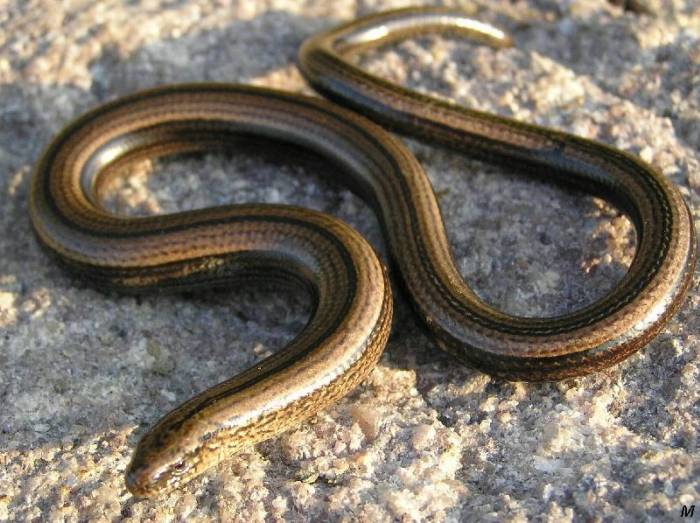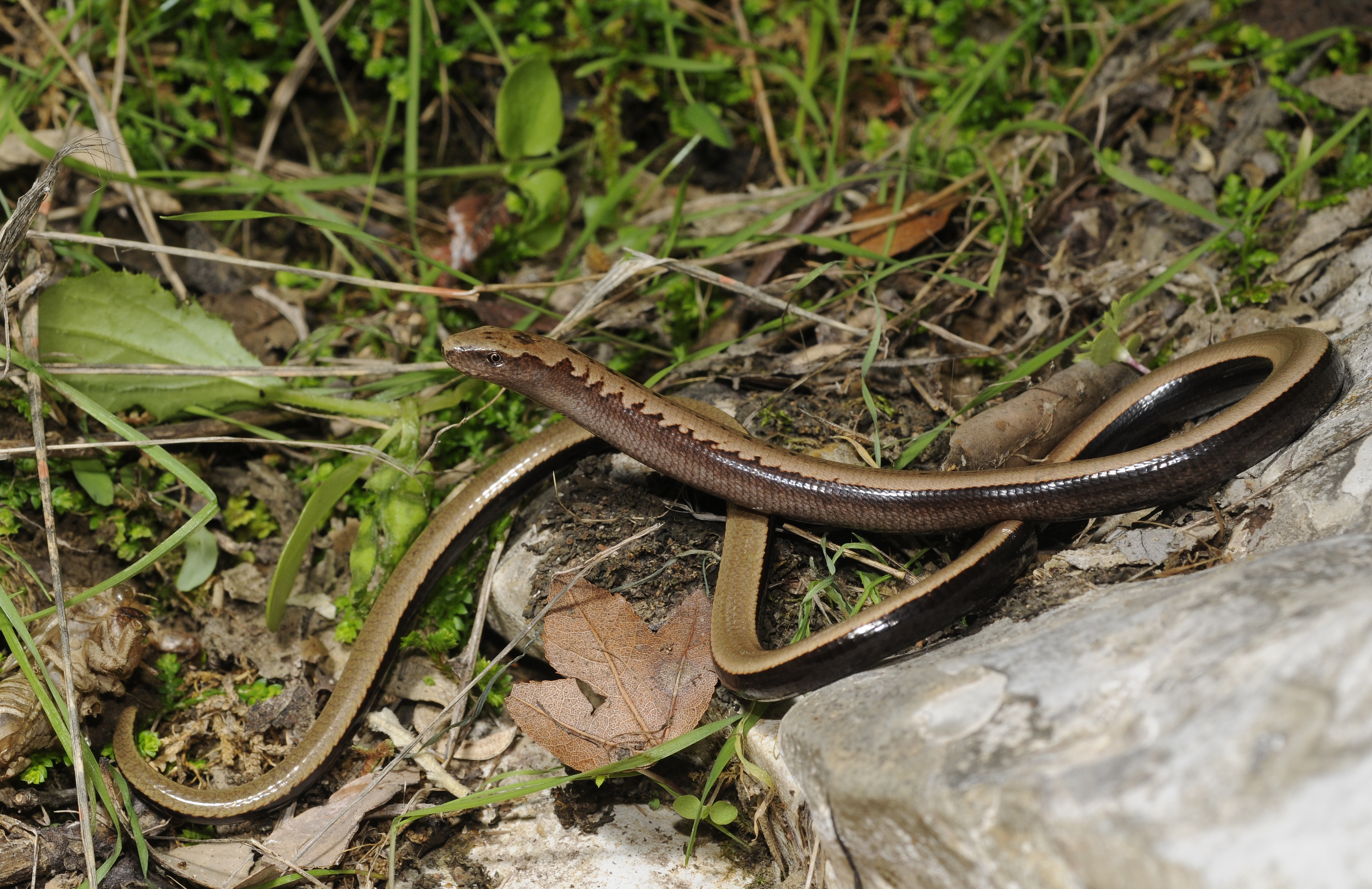The slow worm was @SpeciesofUK from 17th to
23rd February 2013.
Slow worms, despite their name, are not worms, and
despite their appearance, are not snakes. They are lizards.
 |
| Slow Worm [Source: Jonas Bergsten] |
Historically all lizards had legs so the lack of them is
an evolved characteristic. There are a number of families of lizards that have
evolved leglessness, many independently of each other.
Slow worms are very widely distributed in Britain. The
name slow worm is ancient and can be traced back to Old English “slawerm,”
meaning slow snake. It’s also called the blindworm.[1]
 |
| Slow Worm [Source: Marek_bydg] |
In the UK, the slow worm has been granted protected
species status. It is illegal to intentionally kill, injure or sell them.[2]
Distribution
and Habitat
The slow worm is found right across Europe and into
western Asia, although it’s not found in southern Spain/Portugal or in Ireland.[3]
In Britain, the slow worm is found everywhere, but in
general it’s more common in the south and west than the north and east.[4]
Slow worms are not rare but they are elusive. They spend
most of their time in burrows underground, which they make themselves.[5] Typical spots to find them
include wooded areas, church yards, waste ground, allotments and even gardens.[6]
 |
| Slow Worm Revealing Itself [Source: sorundalasse] |
The best times to see slow worms in the open are: early
Spring basking in the Sun, breeding season (May-June), and late summer
(pregnant females basking).[7] Slow worms like humid
conditions and emerge from hiding places at dusk or after rain to hunt for
food, another good time to see them.[8]
Slow worms can be encouraged to make a home in your
garden by placing pieces of corrugated metal or black sheeting on the ground
under which they will shelter.[9]
Slow worms, like many reptiles, hibernate. Some people would argue that they “brumate” because “hibernate” is the word for mammals, but it’s essentially the same thing.
Slow worms, like many reptiles, hibernate. Some people would argue that they “brumate” because “hibernate” is the word for mammals, but it’s essentially the same thing.
Hibernation or brumation is a state of dormancy - all
metabolic processes slow right down. All the UK’s land reptiles do this,
including our slow worms. Slow worms hibernate from October until end
February/March.
Identification
Adult slow worms have a smooth, shiny,
almost “glassy” appearance. However, the males and females are very
different in colour.
Female slow worms are usually brown, copper-coloured or
red on the back, with brown or black sides, often with light iridescent flecks,
and a black belly. On most females there is a distinctive dark vertebral stripe.[10]
 |
| Female Slow Worm with Vertebral Stripe and Flecked Sides [Source: fabelfroh] |
Male slow worms tend to be more uniform in colour,
typically without flecks or stripes. Their colour can be light or dark brown,
grey, bronze or brick red. Crucially, they lack the vertebral stripe that most females
have. Males also have longer, broader heads, and mottled black or dark grey
bellies.[11]
 |
| Male Slow Worm [Source: Roberto Verzo] |
Occasionally, some males also develop extremely
distinctive and unmistakeable bright blue spots.
 |
| Male Slow Worm with Blue Spots [Source: anabis] |
The slow worm always has 26 scales around its body in the
UK. In other countries this can vary.[12]
In juvenile slow worms, it is much harder to tell the
difference between the sexes. The juvenile’s back is iridescent silver, gold, bronze or copper and the sides are pitch
black. They all have the black vertebral stripe that males lose after
about three years, when they reach sexual maturity.[13]
 |
| Juvenile Slow Worm [Source: Dave ®] |
Slow worms are long lived. One individual was recorded at
54 years old. They shed their skin at intervals throughout their life.[14]
Slow worms and snakes
How can you tell the difference between a slow worm and a
snake? It’s actually fairly straightforward once you are familiar with
the species. Here’s five simple pointers:[15]
1. Slow worms are much more uniform in colour than the
UK’s snakes. The vertebral stripe of the female is much straighter than the
zigzag of the adder.
 |
| An Adder [Source: Danny Chapman] |
2. The head of the slow worm is indistinct from the rest
of the body, whereas snakes’ heads stand out more.
3. The slow worm has a much blunter tail than a snake.
4. The slow worm’s scales are small and highly-polished,
giving it a more “glassy” appearance than a snake.
5. Not easy to see, but the slow worm has eyelids, a
typical feature of lizards. Snakes don’t have eyelids.
Behaviour
Slow worms are pretty slow moving, but when startled they
can move quickly, as you can see in this video. They spend a lot of time in their burrows.[16]
Slow worms eat snails, slugs, worms, spider and insects.
They in turn are preyed on by snakes, hedgehogs, badgers, foxes, rats, pheasants, partridges and birds of prey.[17]
In urban areas, the slow worm is easy prey to
the domestic cat, against which it has no defence.[18]
Slow worm courtship happens from mid-May to late June.[19] During mating the male
slow worm seizes the female’s head, they twine their bodies together, and stay
like this for hours.[20] Here is a video.
 |
| Slow Worm Mating [Source: florriebassingbourn] |
During the courting season male slow worms become
extremely aggressive towards one another.[21] You can also see a video of this.
The young take 4-5 months to develop. The slow
worm is “ovoviviparous.” This means the young hatch inside the female.
They are “born” in a membrane that quickly breaks. This happens in August or September.[22]
Slow worms produce an average of eight young, but the
number can vary between 3 and 26. The newborns are only about 7-10cm long.
Autotomy
Like some other lizards, slow worms can shed their tails
when under threat. It’s called “autotomy” and is a pretty amazing escape
mechanism.[23]
It involves shedding part of the tail structure by
squeezing a powerful muscle that shatters a vertabrae.[24]
 |
| Slow Worm which has Shed its Tail [Source: motnworb] |
The shed tail continues to wriggle, distracting the
predator while the slow worm escapes. The new tail starts to grow back in a
couple of weeks.[25]
The Latin name of the slow worm, “anguis fragilis,” means
“fragile snake,” which is a direct reference to this ability to shed its tail
when under threat.[26]
When the tail is still intact, it takes up most of the
slow worm’s length. After it’s been shed several times, the body generally
becomes longer than the tail.[27]
Strange but true…
The genus Anguis, of which the slow worm is a species,
contains only one other species, the “Peloponnese slow worm,” which can be
found in Greece and nowhere else in the world.[28]
 |
| Peloponnese Slow Worm [Source: Benny Trapp] |
No comments:
Post a Comment